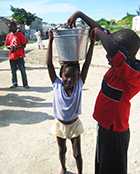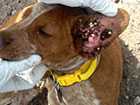Environmental Investigations
Explore findings from our environmental investigations for outbreaks, emergencies, and other environmental health issues.
Foodborne Illness Outbreak Investigations

Environmental Investigation of a Multistate E. coli Outbreak on Spinach
Read about our watershed-scale investigation of the outbreak, including the potential effects of irrigation water quality.
Waterborne Illness Outbreak Investigations

Read this new report about an outbreak in an NYC cooling tower in 2015.

Legionnaires’ Disease Outbreak at a Long-Term Care Facility in Ohio, 2013 [PDF – 688 KB]
On July 9, 2013, an outbreak of Legionnaires’ disease was identified at a Long-Term Care Facility in central Ohio. This article describes the investigation of the outbreak and identification of the source, a cooling tower using an automated biocide delivery system. EHS participated in the environmental assessment.

Irrigation Water Issues Potentially Related to Multistate E. coli Outbreak on Spinach
A restaurant chain received spinach contaminated with E. coli, which made many people ill. Environmental health investigators traced the spinach back to one farm’s irrigation system.

South Bass Island Assessment [PDF – 1.97 MB]
At the request of the Ohio Department of Health, EHS investigated the potential sources of water contamination on South Bass Island in 2004. Ohio asked for assistance because slightly more than 1,000 persons reported a sudden onset of symptoms that included diarrhea, cramps, nausea, and vomiting.

Haiti Assistance after Earthquake
After the devastating earthquake in January 2010 and the cholera outbreak in October 2010, water and sanitation conditions were at crisis levels. Before these events, Haiti had the lowest water and sanitation coverage in the western hemisphere. To address the cholera epidemic, CDC provided targeted technical assistance on water, sanitation, and hygiene. This work is now managed by CDC’s Center for Global Health.
Vectorborne Outbreak Investigations

Rocky Mountain Spotted Fever (RMSF) Rodeo Project
In 2012 CDC began working with American Indian communities in Arizona to control Rocky Mountain spotted fever after an outbreak of the vector borne disease. CDC’s EHS helped develop and implement a reservation-wide dog collaring program to halt disease spread by dogs, the main source of exposure to disease-transmitting ticks.
Other Investigations

Lead Exposure Reduction Plan in La Oroya, Peru
In March 2004, EHS collaborated with other scientists to provide technical assistance in the development of an integrated plan for addressing lead pollution problems in La Oroya, Peru. The team assessed conditions that may be contributing to reported health complaints and elevated blood lead levels in the smelter community of La Oroya.
- Page last reviewed: August 12, 2015
- Page last updated: June 27, 2017
- Content source:


 ShareCompartir
ShareCompartir